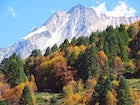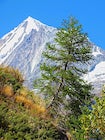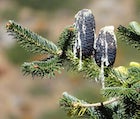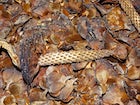Abies spectabilis
(D. Don) Spach 1841
Common names
East Himalayan fir, Webb fir, Sapin de l'Himalaya, Sapin magnifique, 西藏冷杉, தாலிசப்பத்திரி, Пихта замечательная.
Taxonomic notes
Syn: Pinus spectabilis D. Don 1825; Pinus webbiana Wall ex D. Don in Lambert 1828; A. webbiana (Wall ex D. Don) Lindl. 1833; Picea webbiana (Wall ex D. Don) Loudon 1838 (Farjon 1998); A. chiloensis Hort.; A. chilrowensis Hort. Griff. (Vidakovic 1991). Vidakovic (1991) describes a variety brevifolia, reduced to synonymy by Farjon (2010).
Description
"A tree attaining in the E. Himalaya a height of 60 m. Crown broadly conical. Branches horizontally spreading. Bark dark gray, rough and scaly. Shoots red-brown, deeply grooved, pubescent in the grooves. Buds large, globose, resinous. Needles on the upper side of the shoot arranged in several ranks, leaving a V-shaped depression between them, 2-6 cm long, with emarginate apex; upper surface dark green and glossy, with 2 broad stomata bands beneath. Cones cylindrical, 14-20 cm long and about 7 cm thick, violet-purple when young, later brown; seed scales 1.5-2 cm wide; bract scales concealed" (Vidakovic 1991). This description could also apply to Abies densa, which Vidakovic seems not to have discriminated. See Wu and Raven 1999 for a more recent and detailed description.
Distribution and Ecology
Afghanistan: Hindu Kush; India: Himachal Pradesh, Uttarakhand, Sikkim; Nepal; Tibet (Farjon 1998); at 2500-4000 m elevation (Vidakovic 1991).
Firs of the southern Himalaya. Abies pindrow (var. pindrow) in blue, A. spectabilis in green, and A. densa in red. Data source is Conifers of the World (accessed 2019.05.16). Note that A. gamblei is not shown; it occurs locally in India: Himachal Pradesh and Uttarakhand.
Hardy to Zone 7 (cold hardiness limit between -17.7°C and -12.2°C) (Bannister and Neuner 2001).
It commonly occurs as a canopy dominant species in very wet forest, accompanied by species of Rhododendron including R. campanuletum, R. lepedetum, and R. anthapogen, as well as Betula utilis (Yadav et al. 2004, Chhetri 2008) and, at lower elevations, Pinus wallichiana (Tiwari et al. 2017).
A. spectabilis forest in Nepal has been found to be extending its closed canopy and upper treeline forest to higher elevations in response to climate change (Tiwari et al. 2017).
Remarkable Specimens
Carder (1994), citing Elwes and Henry (1909), citing Hooker (1854), state a maximum girth of 35 feet (340 cm dbh). Hooker is a credible authority, but gives no details, except that he saw the tree on the road from Lachung, Sikkim toward the Chumbi Valley, Tibet. That border crossing no longer exists, and the forest in that area has since been heavily logged. Elwes and Henry (1909) actually state "The largest trees which I have found... were on the track from Lachoong to the Tunkra Pass, leading into the Chumbi Valley... must have been nearly 200 feet [61 m] high." Such an ambiguous declaration gives the doubt to the 200 foot estimate; Farjon (2010) gives us "40-50 m" and Debreczy and Racz (2011) say "<60 m". Carder (1994) suggests that the largest specimens should be sought in Bhutan, which has largely escaped the depredations of logging, indiscriminate development, and poor forest management.
I cannot find any precise or modern records for the species in habitat, but Monumental trees (2019) records a maximum girth of 4.37 m (139 cm dbh) for a tree at Kilmacurragh Arboretum, Rathdrum, Ireland and a maximum height of 38 m for a tree at the Taymouth Castle estate, UK.
The oldest known specimen is documented in a tree-ring chronology covering the period 1420-1997 (crossdated after 1587), collected above Gheri in Nepal, elevation 3450 m, by Paul Krusic and Ed Cook (doi.org/10.25921/xtp6-zh97). The oldest tree in the study provided a 577-year record, and 6 other sampled trees were at least 300 years old. All specimens were alive at the time.
Ethnobotany
The species has been used in several dendrochronological studies. Chhetri (2008) briefly describes his own work, performed in 2008, making collections at study sites at the alpine timberline sites (3700 m) near Cholangpati, Nepal, and also in Langtang National Park, Nepal. He also provides the following summary of previous dendrochronological work using this species: "Schmidit et al. (1999) collected 400 archeological wood samples and living trees samples from Mustang region during 1989 and 1992. Tree species used were Pinus wallichiana, Abies spectabilis and Picea smithiana. ... Douglas (2000) reconstructed the temperature of Kalinchok, Nepal with the help of tree ring chronology (1729-1978) of A. spectabilis and found that significant variability in S-O-N [September-October-November] temperatures during the period of reconstruction. Sano et al. (2002) reconstructed the climatic data for past 284 years using A. spectabilis in western Nepal. He found increase in temperature during last 30 years. ... Yasue et al. (2002) developed a chronology of ring width and densities ranging from 1722 to 2000 of central Nepal using A. spectabilis and suggested tree ring width and densities might be good indicators for reconstruction of climate conditions of pre-monsoon. ... Sano et al. (2002) reconstructed past 298 years Pre-monsoon temperature of Eastern Nepal using wood density variables of A. spectabilis and concluded that temperature reconstruction do not show any significant sign of recent global warming as do many of those from higher latitudes as well as in apparent contradiction with massive glacial retreat in the Himalaya over last 100 years or so. Khanal and Rijal (2002) developed 345 years (1656-2001) tree ring chronology based on sample of 48 cores from trees of A. spectabilis from Ganesh Himal Area, Central Nepal and found negative correlation between temperature in May and tree growth and positive correlation between precipitation in April and tree ring growth."
Observations
No data as of 2023.02.22.
Remarks
The epithet spectabilis means "superb".
Citations
Carder, A.C. 1995. Forest giants of the world: past and present. Markham, Ontario: Fitzhenry and Whiteside. 208 pp (p. 129).
Chhetri, Parveen Kumar. 2008. Nepal Dendrochronology. http://nepaldendro.blogspot.com/, accessed 2008.07.24.
Debreczy, Zsolt and Istvan Racz. 2011. Conifers Around the World. 2 vols. Budapest: Dendropress Ltd.
Douglas, D.L 2002. Temperature Variation in Kalinchok, Nepal (1729-1078) using Himalayan Silver Fir trees as proxy data. Arizona State University task force report.
Elwes, H.J. and A. Henry. 1909. The trees of Great Britain and Ireland V. 4. Edinburgh: Privately printed (p. 753). Available: Biodiversity Heritage Library, accessed 2019.03.09.
Farjon, Aljos. 2010. A Handbook of the World's Conifers. 2 vols. Leiden, Netherlands: Brill Academic Publishers.
Hooker, Joseph Dalton. 1854. Himalayan journals. London: J. Murray. 2 vols (V. 2, p. 108). Available: Biodiversity Heritage Library, accessed 2019.03.09.
Khanal, N.R and S.P. Rijal 2002. Tree ring chronology from Ganesh Himal Area, Central Nepal. Pp. 12-19 in Geothermal / Dendrochronological Paleoclimate Reconstruction across Eastern Margin of Eurasia. Proceedings of the 2002 International Mastsuyama Workshop.
Monumental trees. 2019. The thickest, tallest, and oldest East Himalayan firs (Abies spectabilis). https://www.monumentaltrees.com/en/trees/abiesspectabilis/records/, accessed 2019.03.09.
Sano, M., F. Furuta., O. Kobayashi and T. Sweda 2002. Paleoclimate reconstruction for western Nepal based on Abies spectabilis tree-ring width and density. Pp. 2-11 in Geothermal / Dendrochronological Paleoclimate Reconstruction across Eastern Margin of Eurasia. Proceedings of the 2002 International Mastsuyama Workshop.
Schmidit, B., T. Wazny., K. Malla., E. Hofs and M. Khalessi. 1999. Chronologies for Historical Dating in High Asia/Nepal. In R. Wimmer and R.E. Vetter (Eds.) Tree Ring Analysis: Biological, Methodological and Environmental Aspects. CABI International.
Spach. 1841. Histoire Naturelle des Vegetaux. V. 11. Paris: Labrairie Encyclopedique de Roret (p. 422). Available: Biodiversity Heritage Library, accessed 2019.03.09.
Tiwari, A., Z. X. Fan, A. S. Jump, S. F. Li, and Z. K. Zhou. 2017. Gradual expansion of moisture sensitive Abies spectabilis forest in the Trans-Himalayan zone of central Nepal associated with climate change. Dendrochronologia 41:34-43.
Yadav, R.R., J. Singh, B. Dubey, and R. Chaturvedi. 2004. Varying strength of
relationship between temperature and growth of high-level fir at marginal
ecosystems in western Himalaya, India. Current Science 8:1152–1156.
Yasue K., M. Noda., O. Kobayashi., M. Sano., T. Kato and T. Sweda. 2002. Dendroclimatological potential of Abies spectabilis at Khurpudada pass, Ganesh Himal, Central Nepal. Pp. 20 in Geothermal/Dendrochronological Paleoclimate Reconstruction across Eastern Margin of Eurasia. Proceedings of the 2002 International Mastsuyama Workshop.
See also
Elwes and Henry 1906-1913 at the Biodiversity Heritage Library (as A. webbiana) (Photos). This series of volumes, privately printed, provides some of the most engaging descriptions of conifers ever published. Although they only treat species cultivated in the U.K. and Ireland, and the taxonomy is a bit dated, still these accounts are thorough, treating such topics as species description, range, varieties, exceptionally old or tall specimens, remarkable trees, and cultivation. Despite being over a century old, they are generally accurate, and are illustrated with some remarkable photographs and lithographs.
Farjon, Aljos. 1990. Pinaceae: drawings and descriptions of the genera Abies, Cedrus, Pseudolarix, Keteleeria, Nothotsuga, Tsuga, Cathaya, Pseudotsuga, Larix and Picea. Königstein: Koeltz Scientific Books.
- Provides a detailed account, with illustrations.
Farjon (2010).
Jain, K.K. 1976: Introgressive hybridization in the West Himalayan silver firs. Silvae Genetica 25(3-4): 107-109.





